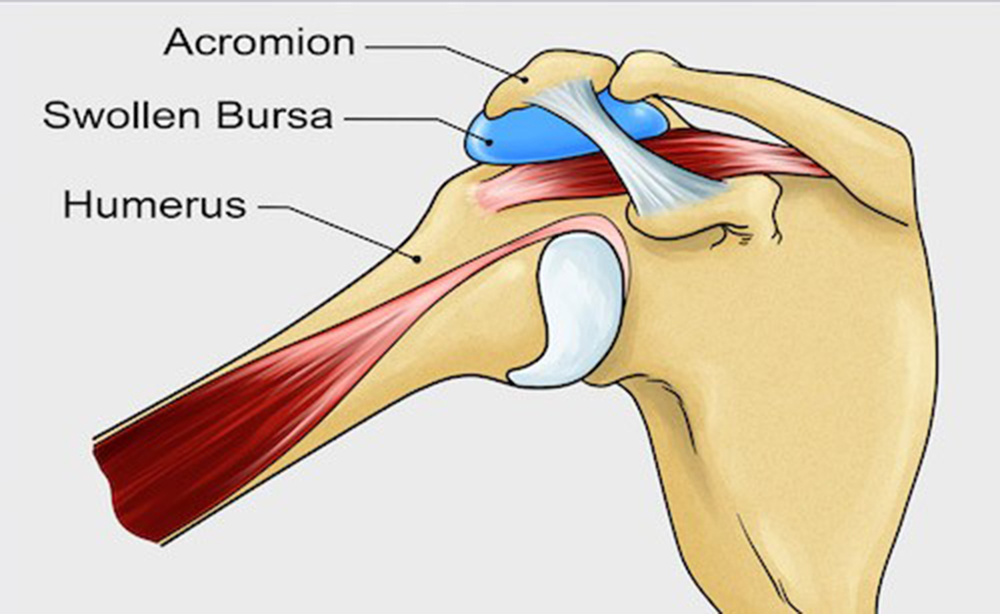What is Shoulder Bursitis
 Shoulder bursitis is an inflammatory condition that affects the Shoulder Bursa. Bursa is a fluid-filled sac that helps to reduce friction between the tendons and bony structure in the subacromial space. The subacromial bursa is the most commonly affected of all the shoulder bursa.
Shoulder bursitis is an inflammatory condition that affects the Shoulder Bursa. Bursa is a fluid-filled sac that helps to reduce friction between the tendons and bony structure in the subacromial space. The subacromial bursa is the most commonly affected of all the shoulder bursa.
The Subacromial Bursa is a common cause of shoulder pain that is usually related to shoulder impingement.
Causes of Shoulder Bursitis:
Shoulder bursitis is usually caused by repeated minor trauma such as repeated overhead use of the arm in sports like swimming, throwing, or in occupations that require frequent overhead activity. It can also occur due to single more significant trauma such as a fall.
In Overuse Type Injuries, bursitis is often associated with impingement and tendonitis of the rotator cuff tendons.
Symptoms of Shoulder Bursitis:
This condition commonly presents with the following symptoms:
- Gradual onset of shoulder pain over weeks
- Pain on the anterolateral aspect of the shoulder or may radiate to the elbow.
- Pain gets worse while lying on the affected shoulder.
- Pain gets worse when the arm at shoulder height.
- A painful arc between 60 – 120 degrees of arm moving up/ down. No pain when arm by the sides or above 120 degrees.
Diagnosis:
The Physiotherapist should be able to differentiate subacromial bursitis with other different shoulder conditions, but most probably chances are that it may co-exist with other shoulder pathologies.
- An ultrasound scan is the most helpful investigation to confirm subacromial bursitis.
- MRI scan may also be useful.
Calcific Shoulder Bursitis
If treating shoulder bursitis is neglected, it can become quite chronic and be very difficult to treat resulting in a cycle of rotator cuff injury and impingement of the shoulder joint. Calcific bursitis (bone growth within the bursa) may occur over time.
If Physiotherapy Rehabilitation is unsuccessful, then surgical excision of the bursa may be required in these instances.
Treatment of Shoulder Bursitis
All the structures under the coracoacromial arch are susceptible to injury including the bursa and rotator cuff tendons in an impingement case.
The ultimate aim of treatment should be to centralize the shoulder ball into its socket, which is the actual function of rotator cuff muscles. This will allow proper slides and glides of the shoulder ball in its socket while dynamically moving the arm over a stable shoulder blade. So it is also very important to ensure a dynamically stable shoulder blade. This will prevent the bursa from impingement.
 In resistant cases or cases not responding well to conservative physiotherapy treatment can undergo corticosteroid injections to reduce the pain and inflammation. It is important to undergo physiotherapy even after corticosteroid injections to gain back strength, power agility, and proprioception and restore the proper scapular position.
In resistant cases or cases not responding well to conservative physiotherapy treatment can undergo corticosteroid injections to reduce the pain and inflammation. It is important to undergo physiotherapy even after corticosteroid injections to gain back strength, power agility, and proprioception and restore the proper scapular position.
(Discuss with your Orthopaedician whether you can undergo a corticosteroid injection as it has its own side effects.)
The treatment progresses through the following stages to achieve the desired result.
- Early Injury Protection
- Regain Full Range of Motion
- Restore normal Scapular-humeral Control
- Restore Rotator Cuff Strength
- Restore proper thoracic and neck alignment
- Restore Strength, Power, and proprioception
- Return to Sport/ Work
Prevention:
Eliminating the primary and secondary causes of shoulder impingement is the key to preventing shoulder bursitis and rotator cuff problems. Factors such as posture, muscle length and strength, shoulder stability, and rotator cuff strength need to be addressed and can be optimized with specific exercises.
For more specific advice please consult our Shoulder Expert at our Physiotherapy Clinic in Dwarka, Delhi.





